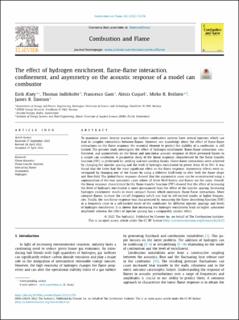| dc.contributor.author | Æsøy, Eirik | |
| dc.contributor.author | Indlekofer, Thomas | |
| dc.contributor.author | Gant, Francesco | |
| dc.contributor.author | Cuquel, Alexis | |
| dc.contributor.author | Bothien, Mirko R. | |
| dc.contributor.author | Dawson, James Richard | |
| dc.date.accessioned | 2022-11-29T07:45:58Z | |
| dc.date.available | 2022-11-29T07:45:58Z | |
| dc.date.created | 2022-05-10T08:59:13Z | |
| dc.date.issued | 2022 | |
| dc.identifier.issn | 0010-2180 | |
| dc.identifier.uri | https://hdl.handle.net/11250/3034624 | |
| dc.description.abstract | To maximise power density practical gas turbine combustion systems have several injectors which can lead to complex interactions between flames. However, our knowledge about the effect of flame-flame interactions on the flame response, the essential element to predict the stability of a combustor, is still limited. The present study investigates the effect of hydrogen enrichment, flame-flame interaction, confinement, and asymmetries on the linear and non-linear acoustic response of three premixed flames in a simple can combustor. A parametric study of the linear response, characterised by the flame transfer function (FTF), is performed for swirling and non-swirling flames. Flame-flame interactions were achieved by changing the injector spacing and the level of hydrogen enrichment by power from 10 to 50%. It was found that the latter had the most significant effect on the flame response. Asymmetry effects were investigated by changing one of the flames by using a different bluff-body to alter both the flame shape and flow field. The global flame response showed that the asymmetric cases can be reconstructed using a superposition of the two symmetric cases where all three bluff-bodies and flames are the same. Overall, the linear response characterised by the flame transfer function (FTF) showed that the effect of increasing the level of hydrogen enrichment is more pronounced than the effect of the injector spacing. Increasing hydrogen enrichment results in more compact flames which minimises flame-flame interactions. More compact flames increase the cut-off frequency which can lead to self-excited modes at higher frequencies. Finally, the non-linear response was characterised by measuring the flame describing function (FDF) at a frequency close to a self-excited mode of the combustor for different injector spacings and levels of hydrogen enrichment. It is shown that increasing the hydrogen enrichment leads to higher saturation amplitude whereas the effect of injector spacing has a comparably smaller effect. | en_US |
| dc.language.iso | eng | en_US |
| dc.publisher | Elsevier | en_US |
| dc.rights | Navngivelse 4.0 Internasjonal | * |
| dc.rights.uri | http://creativecommons.org/licenses/by/4.0/deed.no | * |
| dc.title | The effect of hydrogen enrichment, flame-flame interaction, confinement, and asymmetry on the acoustic response of a model can combustor | en_US |
| dc.title.alternative | The effect of hydrogen enrichment, flame-flame interaction, confinement, and asymmetry on the acoustic response of a model can combustor | en_US |
| dc.type | Peer reviewed | en_US |
| dc.type | Journal article | en_US |
| dc.description.version | publishedVersion | en_US |
| dc.source.journal | Combustion and Flame | en_US |
| dc.identifier.doi | 10.1016/j.combustflame.2022.112176 | |
| dc.identifier.cristin | 2022918 | |
| cristin.ispublished | true | |
| cristin.fulltext | original | |
| cristin.qualitycode | 2 | |

